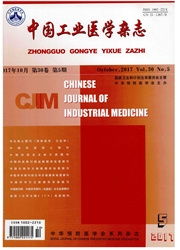

 中文摘要:
中文摘要:
目的研究三氯乙烯致敏小鼠体内激肽释放酶-激肽系统(KKS)表达水平,探讨职业性三氯乙烯药疹样皮炎(ODMLT)的发病机制。方法将130只雌性6—8周BALB/c小鼠随机分成空白对照组、溶剂对照组、TCE处理组和TCE+PKSI-527处理组:TCE+PKSI.527处理组在17d和19d两次激发前24h腹腔内注射抑制剂PKSI-527;分别于末次激发后24h、48h、72h和7d处死动物,造模期间实时记录小鼠体重,计算脏器系数,ELISA法检测血浆前激肽释放酶(PK)、高分子量激肽原(HMWK)和缓激肽(BK)水平。结果TCE处理组的致敏率为40%,以PKSI-527干预后的致敏率为21.67%,TCE致敏组及TCE+PKSI-527组体重与空白对照组相比均明显减少;TCE处理组小鼠48h、72h的肝脏系数明显高于空白对照组,而使用PKSI-527干预后小鼠肾脏系数和脾脏系数均有好转。TCE处理组48h、72h时致敏小鼠血浆中PK浓度明显高于溶剂对照组及相应的未致敏组,且在72h时点达到峰值,使用PKSI-527能够显著降低PK浓度。TCE处理组24h、48h致敏小鼠血浆中HMWK浓度明显高于溶剂对照组及相应的未致敏组;TCE+PKSI-527处理组48h时HMWK浓度明显低于相应时段TCE致敏组。血浆BK的变化特点基本与PK和HMWK表达一致。结论KKS活化可能参与TCE小鼠致敏及脏器免疫损伤过程。
 英文摘要:
英文摘要:
Objective To study the expression level of katlikrein-kinin system in trichloroethylene sensitized mice, thereby explore the pathogenesis of occupational dermatitis medicamentosa-like of trichloroethylene (ODMLT). Methods 130 female 6- 8 weeks old BALB/c mice were randomly divided into blank control group, solvent control, TCE treatment group and TCE+PKSI-527 treatment group; the mice of TCE+PKSI-527 treatment group were injected inhibitor PKSI-527 24 h earlier before 17 d and 19 d sensitization, respectively. The ani- mals were killed at 24 h, 48 h, 72 h and 7 d respectively after the last injection. Record mice body weight changes and organ coefficients during the period of making model ; the levels of lasma PK, HMWK and BK were detected by ELISA assay. Results The study found that the sensitization rate of TCE treatment group was 40%, the rate was only 21.67% after intervention of PKSI-527 ; the body weights of TCE sensitized group and TCE+PKSI-527 weight group were all significantly reduced compared with control group; the organ coefficients of liver in TCE treatment group was significantly higher than the control group at 48 h and 72 h of experiment, the PKSI-527 intervention might obvi- ously improve kidney and spleen coefficients; plasma PK were significantly higher than solvent control group and corresponding non-sensitized group at 48 h and 72 h and the peak was 72 h, PKSI-527 could significantly reduce the concentration of PK; plasma HMWK levels of TCE sensitized group were also significantly higher than solvent control group and corresponding non-sensitized group at 48 h and 72 h, and which was significantly lower than that of TCE sensitized group at 48 h ; additionally, the changes of plasma BK was also roughly consistent with the expression of PK and HMWK. Conclusion KKS activation may be involved in the processes of sensitization and immunologic organ damage in TCE sensitized mice.
 同期刊论文项目
同期刊论文项目
 同项目期刊论文
同项目期刊论文
 期刊信息
期刊信息
